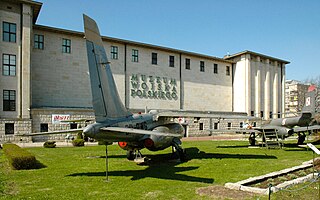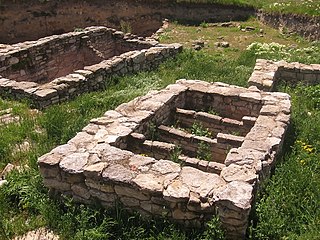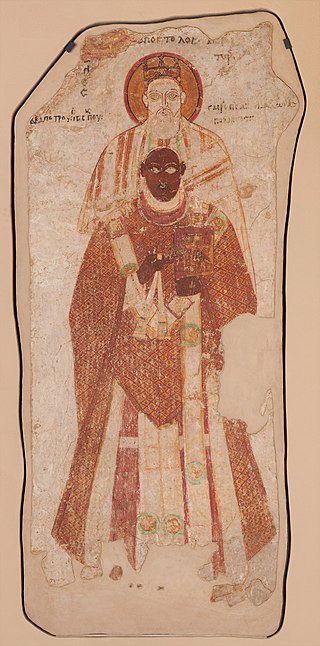
The Bosporan Kingdom, also known as the Kingdom of the Cimmerian Bosporus, was an ancient Greco-Scythian state located in eastern Crimea and the Taman Peninsula on the shores of the Cimmerian Bosporus, centered in the present-day Strait of Kerch. It was the first truly 'Hellenistic' state, in the sense that a mixed population adopted the Greek language and civilization, under aristocratic consolidated leadership. Under the Spartocid dynasty, the aristocracy of the kingdom adopted a double nature of presenting themselves as archons to Greek subjects and as kings to barbarians, which some historians consider unique in ancient history. The Bosporan Kingdom became the longest surviving Roman client kingdom. The 1st and 2nd centuries AD saw a period of a new golden age of the Bosporan state. It was briefly incorporated as part of the Roman province of Moesia Inferior from 63 to 68 AD under Emperor Nero, before being restored as a Roman client kingdom. At the end of the 2nd century AD, King Sauromates II inflicted a critical defeat on the Scythians and included all the territories of the Crimean Peninsula in the structure of his state.

Kazimierz Józef Marian Michałowski was a Polish archaeologist and Egyptologist, art historian, member of the Polish Academy of Sciences, professor ordinarius of the University of Warsaw as well as the founder of the Polish school of Mediterranean archaeology and a precursor of Nubiology.

Greek Crimea concerns the ancient Greek settlements on the Crimean Peninsula. Greek city-states first established colonies along the Black Sea coast of Crimea in the 7th or 6th century BC. Several colonies were established in the vicinity of the Kerch Strait, then known as the Cimmerian Bosporus. The density of colonies around the Cimmerian Bosporus was unusual for Greek colonization and reflected the importance of the area. The majority of these colonies were established by Ionians from the city of Miletus in Asia Minor. By the mid-1st century BC the Bosporan Kingdom became a client state of the late Roman Republic, ushering in the era of Roman Crimea during the Roman Empire.

The National Museum in Warsaw, popularly abbreviated as MNW, is a national museum in Warsaw, one of the largest museums in Poland and the largest in the capital. It comprises a rich collection of ancient art, counting about 11,000 pieces, an extensive gallery of Polish painting since the 16th century and a collection of foreign painting including some paintings from Adolf Hitler's private collection, ceded to the museum by the American authorities in post-war Germany. The museum is also home to numismatic collections, a gallery of applied arts and a department of oriental art, with the largest collection of Chinese art in Poland, comprising some 5,000 objects.

Museum of the Polish Army is a museum in Warsaw documenting the military history of Poland. Established in 1920 under the Second Polish Republic, it occupies a wing of the building of the Polish National Museum as well as several branches in Poland. It is Warsaw's second largest museum and the largest collection of military objects in Poland. The collection illustrates a thousand years of Polish military history, from the 10th century to the Second World War.

Tyritáke was an ancient Greek town of the Bosporan Kingdom, situated in the eastern part of Crimea, about 11 km to the south from Panticapaeum.

Kimmerikón was an ancient Greek city in Crimea, on the southern shore of the Kerch Peninsula, at the western slope of Mount Opuk, roughly 40 kilometres southwest of modern Kerch. It was situated with its acropolis on the hills on the west side of the mountain. The town was founded by the Milesian colonists in the 5th century BC and flourished at the beginning of the Christian era. Its name may refer to an earlier Cimmerian settlement on the site.

Nýmphaion, also known as Nymphaion on the Pontus, was a significant centre of the Bosporan Kingdom, situated on the Crimean shore of the Cimmerian Bosporus. Today it is located near the resort town Heroivske/Geroevskoye. It lies at a distance of about 14 kilometers south of Kerch, which was the site of ancient Panticapaeum.

Stanisław Żaryn was an architect, urbanist, historian and academic teacher who significantly contributed to the process of the reconstruction of historical Polish architecture after its destruction by the Germans during WWII. He was born in Warsaw to Eugenia and Franciszek Zaryn.

Wincenty Fryderyk de Lesseur, or Lesserowicz was a Polish painter, miniaturist, pastelist and caricaturist.
Dynamis, nicknamed Philoromaios, was a Roman client queen of the Bosporan Kingdom during the Late Roman Republic and part of the reign of Augustus, the first Roman Emperor. Dynamis is an ancient Greek name which means the “powerful one”. She was a monarch of Iranian and Greek Macedonian ancestry. She was the daughter of King Pharnaces II of Pontus and his Sarmatian wife. She had an older brother called Darius and a younger brother called Arsaces. Her paternal grandparents had been the monarchs of the Kingdom of Pontus, Mithridates VI of Pontus and his first wife Laodice, who was also his sister. Dynamis married three times. Her husbands were Asander, a certain Scribonius and Polemon I of Pontus. According to Rostovtzeff, she also had a fourth husband, Aspurgos.

Tiberius Julius Sauromates II Philocaesar Philoromaios Eusebes, also known as Sauromates II (Greek: Τιβέριος Ἰούλιος Σαυρομάτης Β΄ Φιλοκαῖσαρ Φιλορωμαῖος Eὐσεβής, Philocaesar Philoromaios Eusebes, the epithets meaning "friend of Caesar, friend of Rome, pious one," was a Roman client king of the Bosporan Kingdom. His coins are known from the period 172–210, probably accounting for his entire reign.
Leucon I of Bosporus also known as Leuco, was a Spartocid ruler of the Bosporan Kingdom who ruled from 389 to 349 BC. He was arguably the greatest ruler of the Bosporan Kingdom.

Jerzy Władysław Kolendo was an acknowledged Polish authority on the history and archaeology of Ancient Rome. He was an exponent of the French Annales school, an epigraphist and specialist in the relations between the Barbaricum and the early Roman Empire.

The Battle of Orsha is a painting of the Battle of Orsha, which was fought on September 8, 1514 between the allied forces of the Grand Duchy of Lithuania and the Kingdom of Poland against the Vasili III's army of the Grand Duchy of Moscow (left) as part of the Muscovite–Lithuanian Wars.

Bishop Petros with Saint Peter the Apostle is a Nubian Christian wall painting from the last quarter of the 10th century. Made with tempera on silt plaster using an al secco fresco technique, it depicts Petros, the bishop of Faras between 974 and 997. The anonymous work was discovered in the ruins of Faras Cathedral, an important religious centre of Nubia, in modern Sudan. Rescued from flooding when Lake Nasser was created, since 1964 it is part of the Faras Gallery of the National Museum in Warsaw.
Stefan Karol Jakobielski is a Polish historian, archaeologist, philologist, epigraphist. One of the pioneers of nubiology. He participated in archaeological research in Faras, Tell Atrib, Palmyra, Deir el-Bahari and Qasr Ibrim; directed the archaeological works at Old Dongola.

Mountainous Landscape with Figures and a Donkey is an oil-on-panel painting by Flemish painter Joos de Momper. It was completed in the early 17th century. The painting is currently housed at the National Museum in Warsaw, which acquired it in 1917.

Mountain Landscape with Campers and a Broken Tree is an oil-on-panel painting by Flemish painter Joos de Momper. The painting is currently housed at the National Museum in Warsaw.















